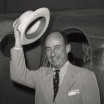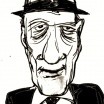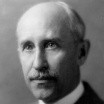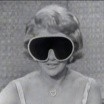Bush, Broderick, Burroughs and More
Yes, bad things happen to good people. Bad things sometimes also happen to famous people. Here are some well-known people with something unusual in common: they all accidentally killed someone.
 Two days after her 17th birthday, on the evening of November 6, 1963, Laura Welch failed to stop her Chevy sedan at a stop sign and smashed into a Corvair being driven by a school chum, Michael Douglas, also 17.
Two days after her 17th birthday, on the evening of November 6, 1963, Laura Welch failed to stop her Chevy sedan at a stop sign and smashed into a Corvair being driven by a school chum, Michael Douglas, also 17.
Laura and her passenger, Judy Dykes, were treated for minor injuries at a nearby hospital, where they learned that Douglas had died from his injuries. No police charges were filed, apparently, but paperwork from the accident is missing or unclear and the details of the incident are a bit of a mystery.
Now Laura Welch is married to former U. S. president George W. Bush and is known around the world as LAURA BUSH. The story made national news during the presidential election of 2000, but little new information came to light. At the time her spokesman, Andrew Malcolm, said “To this day Mrs. Bush remains unable to talk about it.”
 Pop singer and TV star BRANDY, known to TV audiences as the title character from the sitcom Moesha, was driving 65 mph down the 405 freeway in Los Angeles on December 30, 2006 when she rear-ended Awatef Aboudihaj’s Honda. Aboudihaj and her two young sons then hit another car before being struck by a fourth car. Aboudihaj died later from injuries.
Pop singer and TV star BRANDY, known to TV audiences as the title character from the sitcom Moesha, was driving 65 mph down the 405 freeway in Los Angeles on December 30, 2006 when she rear-ended Awatef Aboudihaj’s Honda. Aboudihaj and her two young sons then hit another car before being struck by a fourth car. Aboudihaj died later from injuries.
Police reportedly urged the prosecution of Brandy, while admitting there was no evidence of alcohol or drug involvment. Investigations of the accident continued as Brandy got hit with lawsuits, first by the parents of the deceased, then on behalf of her children.
 In 1988, near Enniskillen in County Fermanagh, Northern Ireland, movie star MATTHEW BRODERICK was driving a rented BMW and inexplicably crossed the center lane, crashing head-on into a Volvo carrying local woman Anna Gallagher and her mother, Margaret Dougherty.
In 1988, near Enniskillen in County Fermanagh, Northern Ireland, movie star MATTHEW BRODERICK was driving a rented BMW and inexplicably crossed the center lane, crashing head-on into a Volvo carrying local woman Anna Gallagher and her mother, Margaret Dougherty.
Both of the Irish women were killed. Broderick’s passenger, actress Jennifer Grey, escaped with minor injuries, and Broderick ended up in an Irish hospital with a concussion, broken leg and collapsed lung.
Broderick was charged with causing death by dangerous driving, but ended up being convicted of the lesser charge of careless driving. He paid a fine of $175. At the time the women’s family called the conviction and fine a “travesty of justice,” but in 2002 Broderick and the family tried to patch things up.
 Democrat ADLAI STEVENSON was governor of Illinois (1949-53) and presidential candidate against Dwight D. Eisenhower in 1952 and 1956, then ambassador to the United Nations under President John F. Kennedy.
Democrat ADLAI STEVENSON was governor of Illinois (1949-53) and presidential candidate against Dwight D. Eisenhower in 1952 and 1956, then ambassador to the United Nations under President John F. Kennedy.
But in 1913, just before his 13th birthday, Stevenson was handling a .22 caliber rifle at a Christmas party and the gun went off, killing 15-year-old Ruth Merwin. The New York Times reported that boys at the party “were students at a military academy, and in the evening they decided to give part of their drill. They found an old repeating rifle and, they thought, took out all the cartridges. In the drill the weapon, when in the hands of young Stevenson, was discharged. The bullet struck Miss Merwin in the forehead and caused instant death.”
The shooting was ruled accidental and no charges were ever filed against Adlai Stevenson. According to biographer Porter McKeever, Stevenson was asked by a reporter in 1952 about the incident and confirmed its truth, but the childhood tragedy was never widely reported by the press.
 Running from trouble with the law over his illegal drug use, WILLIAM S. BURROUGHS left New York for Texas in 1946. He sent for his common-law wife, Joan Vollmer Adams, and together they lived in Texas until 1948, when they moved to New Orleans. Again in trouble with the law over narcotics charges, they moved to Mexico City in 1949 and continued to fuel themselves with booze and benzedrine.
Running from trouble with the law over his illegal drug use, WILLIAM S. BURROUGHS left New York for Texas in 1946. He sent for his common-law wife, Joan Vollmer Adams, and together they lived in Texas until 1948, when they moved to New Orleans. Again in trouble with the law over narcotics charges, they moved to Mexico City in 1949 and continued to fuel themselves with booze and benzedrine.
On September 6, 1951, during a party of sorts, William decided to show off his pistol skills and called for Joan to help him with his “William Tell act.” She placed a glass on her head and turned to the side and Bill fired the pistol. The bullet hit Joan in the head and killed her, and Bill was charged with criminal imprudence, then released on bail. He sent his infant son to stay with his parents in Florida, and he lit out for South America and Tangiers.
Burroughs later claimed that he never would have become a writer had he not shot Joan in the head.
 In the early 1930s, future director JOHN HUSTON was considered a rising young talent in the movie business. A studio screenwriter, Huston was also a natural raconteur and ardent carouser.
In the early 1930s, future director JOHN HUSTON was considered a rising young talent in the movie business. A studio screenwriter, Huston was also a natural raconteur and ardent carouser.
Huston was driving on Sunset Boulevard on September 25, 1933, when he hit a woman pedestrian, killing her. A grand jury was convened, but returned no charges against him.
Huston left the United States for Europe and didn’t return to Hollywood until 1937. He went on to direct some of the most famous films of the 20th century, including The Maltese Falcon (1941), The African Queen (1951) and The Man Who Would Be King (1975).
 On the evening of February 13, 2002, former New Jersey Nets power forward JAYSON WILLIAMS and some friends attended a Harlem Globetrotters basketball game. After the game, Williams took his associates Kent Culuko and John Gordnick (and Gordnick’s two children) to dinner, along with four members of the Globetrotters team. From the restaurant they hired Costas “Gus” Christolfi to drive them to Williams’s mansion in Milford, New Jersey.Around 2:40 a.m. on 14 February, Williams was giving the group a tour and showing off his gun collection. Somehow a shotgun went off and killed Christolfi. Williams’s brother called 911 and told the operator that Christolfi shot himself. The coroner reported that the shotgun blast came from “intermediate range,” and the police accused Williams of recklessly handling the shotgun and then trying to make it look like Christolfi had committed suicide. Both Culuko and Gordnick entered pleas of guilty on charges of evidence and witness tampering and agreed to testify against Williams: Culuko says he wiped fingerprints off the gun and agreed to lie to the police, and Gordnick says he hid Williams’s clothes after the shooting. Williams entered a not guilty plea and went to trial on several counts, including aggravated manslaughter. In April of 2004 he was found not guilty on the most serious charges and guilty of four lesser charges; the jury could not reach a decision on the charge of reckless manslaughter.
On the evening of February 13, 2002, former New Jersey Nets power forward JAYSON WILLIAMS and some friends attended a Harlem Globetrotters basketball game. After the game, Williams took his associates Kent Culuko and John Gordnick (and Gordnick’s two children) to dinner, along with four members of the Globetrotters team. From the restaurant they hired Costas “Gus” Christolfi to drive them to Williams’s mansion in Milford, New Jersey.Around 2:40 a.m. on 14 February, Williams was giving the group a tour and showing off his gun collection. Somehow a shotgun went off and killed Christolfi. Williams’s brother called 911 and told the operator that Christolfi shot himself. The coroner reported that the shotgun blast came from “intermediate range,” and the police accused Williams of recklessly handling the shotgun and then trying to make it look like Christolfi had committed suicide. Both Culuko and Gordnick entered pleas of guilty on charges of evidence and witness tampering and agreed to testify against Williams: Culuko says he wiped fingerprints off the gun and agreed to lie to the police, and Gordnick says he hid Williams’s clothes after the shooting. Williams entered a not guilty plea and went to trial on several counts, including aggravated manslaughter. In April of 2004 he was found not guilty on the most serious charges and guilty of four lesser charges; the jury could not reach a decision on the charge of reckless manslaughter. Famed aviator ORVILLE WRIGHT had a historically deadly crash while testing a new aircraft for the U. S. Army on September 17, 1908 at Fort Meyer, Virginia. Signal Corps aviation expert Lt. Thomas E. Selfridge was riding along as a passenger. Selfridge was an experienced aviator who had worked with Alexander Graham Bell on his experimental flying machines. Expecting to go an hour or more, Wright and Selfridge took off a little after five o’clock in the afternoon. After the plane had made a few turns around the airfield, its wood propeller snapped, sending a shattered piece across a bracing wire and forcing the aircraft into a nosedive.Orville shut off the engine and tried to stablize the craft, which was dropping from a height of at least 60 feet and hurtling toward the ground at a 45-degree angle. Nothing could be done and the plane crashed, pinning the two men beneath it. Orville suffered leg fractures, broken ribs and an injured back. Lt. Selfridge received a terrible compound fracture at the base of his skull; despite emergency surgery, he died about three hours later without ever regaining consciousness. He was the first person ever killed in a plane crash. Selfridge was buried at Arlington National Cemetery, a few hundred feet from where the plane crashed.
Famed aviator ORVILLE WRIGHT had a historically deadly crash while testing a new aircraft for the U. S. Army on September 17, 1908 at Fort Meyer, Virginia. Signal Corps aviation expert Lt. Thomas E. Selfridge was riding along as a passenger. Selfridge was an experienced aviator who had worked with Alexander Graham Bell on his experimental flying machines. Expecting to go an hour or more, Wright and Selfridge took off a little after five o’clock in the afternoon. After the plane had made a few turns around the airfield, its wood propeller snapped, sending a shattered piece across a bracing wire and forcing the aircraft into a nosedive.Orville shut off the engine and tried to stablize the craft, which was dropping from a height of at least 60 feet and hurtling toward the ground at a 45-degree angle. Nothing could be done and the plane crashed, pinning the two men beneath it. Orville suffered leg fractures, broken ribs and an injured back. Lt. Selfridge received a terrible compound fracture at the base of his skull; despite emergency surgery, he died about three hours later without ever regaining consciousness. He was the first person ever killed in a plane crash. Selfridge was buried at Arlington National Cemetery, a few hundred feet from where the plane crashed. Actor and game show panelist ARLENE FRANCIS took the blame for one of the stranger accidental deaths on record, when an exercise dumbbell fell from her eighth-story Manhattan apartment in and killed a man who had just emerged from the popular Le Pavillion restaurant. In her 1978 autobiography, Francis reported that she had been having the apartment cleaned while she appeared in a summer stock play in Westport, Connecticut during the summer of 1962. A maid had placed the dumbbells on the sill to anchor a towel covering the window where an air conditioner had been removed. According to Francis, “While the shutters were being cleaned, the dumbbells became dislodged, one falling into the room and the other out of the window.” Francis paid a settlement to the man’s family, but was not charged with a crime. Francis was involved in another deadly accident in 1963: while she was driving in heavy traffic on a rainy night on Long Island, her car skidded out of control and into the path of an oncoming car. Francis suffered a concussion and broken collarbone, but a woman in the other car was killed. Her survivors sued Francis for $1.5 million, but later settled the case out of court.
Actor and game show panelist ARLENE FRANCIS took the blame for one of the stranger accidental deaths on record, when an exercise dumbbell fell from her eighth-story Manhattan apartment in and killed a man who had just emerged from the popular Le Pavillion restaurant. In her 1978 autobiography, Francis reported that she had been having the apartment cleaned while she appeared in a summer stock play in Westport, Connecticut during the summer of 1962. A maid had placed the dumbbells on the sill to anchor a towel covering the window where an air conditioner had been removed. According to Francis, “While the shutters were being cleaned, the dumbbells became dislodged, one falling into the room and the other out of the window.” Francis paid a settlement to the man’s family, but was not charged with a crime. Francis was involved in another deadly accident in 1963: while she was driving in heavy traffic on a rainy night on Long Island, her car skidded out of control and into the path of an oncoming car. Francis suffered a concussion and broken collarbone, but a woman in the other car was killed. Her survivors sued Francis for $1.5 million, but later settled the case out of court.